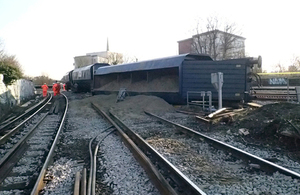Report 04/2018: Freight train derailment at Lewisham
RAIB has today released its report into a freight train derailment at Lewisham, south-east London, on 24 January 2017.

Image of the derailed wagons
Summary
At about 05:30 hrs on 24 January 2017 two wagons within an aggregate train derailed on newly-laid track at Courthill Loop South Junction in Lewisham, south-east London. The first of the wagons ran derailed, damaging the track, then overturned spilling its payload of sand. There was major disruption to rail services while the wagons were recovered and the infrastructure reinstated. No-one was injured.
The new track had been installed during renewal w ork on the weekend of 14 and 15 January 2017. It was made up of separate panels of switch and crossing track, comprising the rails, point and crossing components and the supporting concrete bearers. Most of these track panels had been brought to site pre-assembled. A mechanical connector, known as a ‘bearer tie’, was used to join the concrete bearers that were designed to support rails on more than one panel. Network Rail originally developed the concept for this type of track in the mid-2000s; it is referred to as ‘modular S&C’.
Planned follow-up engineering work was undertaken on the subsequent weekend. The derailment happened on the day after hand-back checks on completion of this work had confirmed that the track geometry was suitable for the passage of trains. It occurred because the first of the two derailed wagons, which was probably carrying an uneven payload, encountered a significant track twist, resulting in there being insufficient wheel load at the leading left-hand wheel to prevent its flange climbing over the rail head.
The track twist had developed rapidly following the hand-back because:
- the support offered by the track bed to the concrete bearers was poor
- the inherent flexibility of the bearer ties located between the two running rails made one side of the track more susceptible to the poor track bed support than the other
Network Rail’s engineering processes for specifying and developing modular S&C layouts were an underlying factor, in that they were inadequate for controlling the risks associated with flange climb derailment.
Recommendations
The RAIB has made five recommendations:
-
Four are directed to Network Rail, concerned with:
-
the processes it uses to identify and manage risks associated with vertical track geometry features following track renewal and heavy maintenance
-
the design and validation of its modular S&C layouts
-
-
One is directed to RSSB concerned with understanding and managing the derailment risks associated with uneven loading of bulk hopper wagons
The RAIB has additionally identified learning points concerning the management and planning of track installation work, and procedures for the routine maintenance of railway vehicles.
Simon French, Chief Inspector of Rail Accidents said:
Derailments of freight trains on the main line are not very common, but when they occur they have the potential to cause very serious consequences, as well as huge disruption to other services. The accident at Lewisham in January 2017 resulted in days of cancellations and delayed trains on some of the busiest commuter routes in the country. If there had been another train nearby when the accident happened, the subsequent collision could have been disastrous.
This accident was particularly disappointing because it happened immediately after the renewal of the track at a complex junction, which had been done with the latest design of modular, pre-assembled switches and crossings. The designers of the new layout had not fully understood how this type of assembly could behave if the track bearers were not fully supported by the ballast. The track was poorly supported when it was handed back for traffic on the day before the derailment, because there had not been time for the machines to finish tamping the ballast, and manual consolidation work was ineffective. The effect of all these deficiencies was to create a situation in which, when it was handed over for traffic the track had, or very rapidly developed, geometry faults. These created the conditions for the wheels of a freight train with a slightly offset payload to climb over the head of the rail.
RAIB has investigated this interaction between poor track geometry and unevenly loaded trains several times before. In reports on investigations published in 2009 and 2014 we have recommended action to deal with the problem. It is of concern to me that, although the railway industry has established a working group to examine these issues, it remains unclear how its findings will be translated into actions to mitigate the risk of freight train derailment.
Notes to editors
- The sole purpose of RAIB investigations is to prevent future accidents and incidents and improve railway safety. RAIB does not establish blame, liability or carry out prosecutions.
- RAIB operates, as far as possible, in an open and transparent manner. While our investigations are completely independent of the railway industry, we do maintain close liaison with railway companies and if we discover matters that may affect the safety of the railway, we make sure that information about them is circulated to the right people as soon as possible, and certainly long before publication of our final report.
- For media enquiries, please call 01932 440015.
Newsdate: 28 February 2018